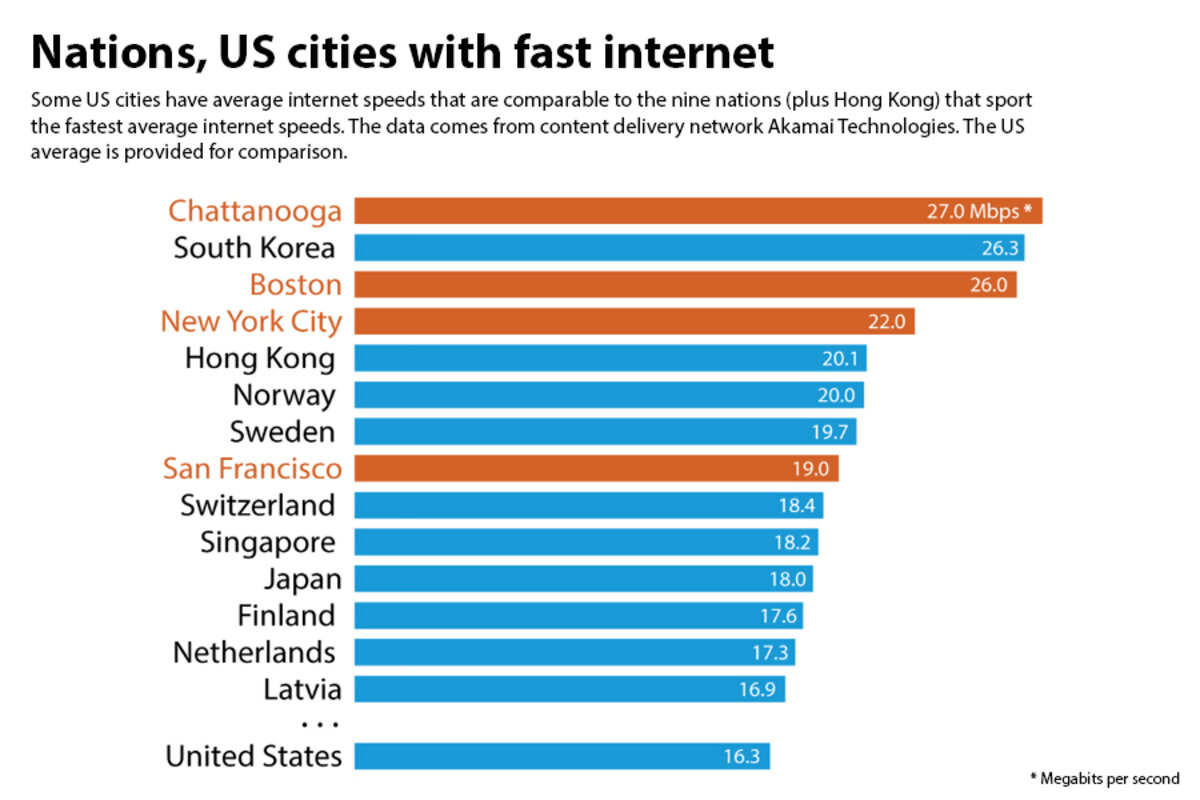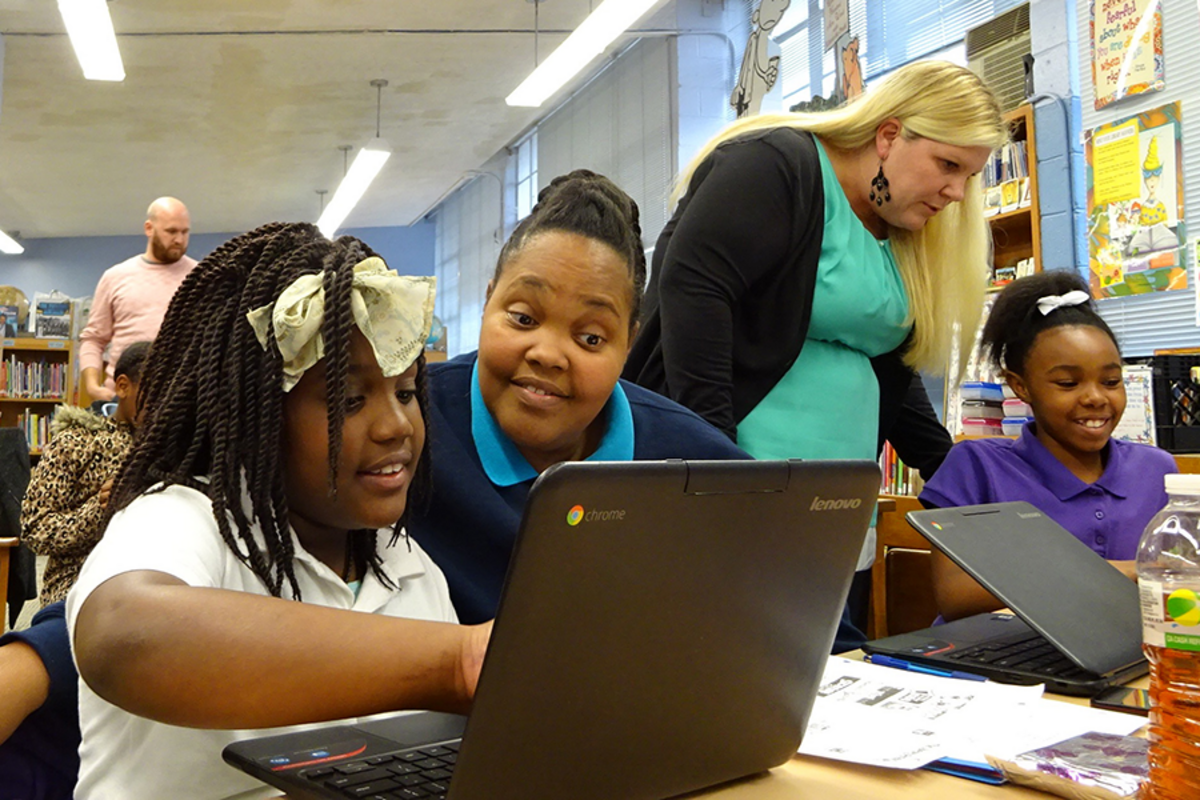How Chattanooga aims to cut poverty with superfast internet
Loading...
| CHATTANOOGA, Tenn.
In Chattanooga’s once dilapidated downtown, Goodman Coffee Roasters serves bespoke beverages to Millennials staring at screens. The converted brick warehouse complex that it’s tucked into also features a yoga studio, LuLuLemon, and a chic restaurant serving modern Southern food. Three blocks away, at the Dwell Hotel, one of a half-dozen hotel and lodging developments coming downtown, visitors lounge at a cocktail bar with vintage furniture against color-splashed walls.
Why is Chattanooga growing so hip? Entrepreneurs and global companies, including Volkswagen and Amazon, are moving here, drawn in part by the city’s superfast gigabit internet, nicknamed “the Gig” by locals. The city is now one of the most connected places on earth, with one of the fastest internet speeds in the world (see chart below).
Yet, a few miles east of downtown, in low-income and largely minority neighborhoods like Brainerd, the buzz of progress peters out. A fifth of Chattanooga’s African-American households and a third of its Hispanic households don’t own a computer, let alone have home access to the internet, according to the latest census data. The result is a digital divide larger than the national average.
For a former industrial manufacturing town with ambitions of building a high-tech economy, this digital imbalance worries city leaders. It could help perpetuate poverty in a city with higher-than-average poverty rates, especially among minorities. It could also stall growth.
“I don’t worry that [start-ups] are going to leave because they have capital opportunities elsewhere, or desires to be elsewhere from a quality-of-life standpoint,” says Andy Berke, the city’s mayor, sitting in a nook of the bustling Edney Innovation Center, Chattanooga’s downtown entrepreneurial hub. “The reason that we worry about [start-ups] moving is that they won’t have the number of people that they need to service their businesses…. We want to be a city that solves those issues.”
Chattanooga is among many US cities trying to prepare its disadvantaged residents for a highly skilled future. It’s a steep challenge, especially for poor cities.
Nationally, low-income people have the least access to the internet. Fewer than half of the poorest fifth of households use internet at home versus 95 percent of households in the top fifth, according to a 2014 study by the Council of Economic Advisers. And the adoption of home broadband service (the fastest internet available) seems to have plateaued, according to a 2015 survey by the Pew Research Center.
Here in Chattanooga, even hefty discounts on the 1 gigabit-per-second internet – a speed that allows users to download a full, high-definition movie in about 30 seconds – has not attracted a greater-than-average share of black or Hispanic households. While 80 percent of the city’s white households had broadband in 2015, close to the US average, only 63 percent of black and 60 percent of Hispanic households did, according to census data. That’s a gap of 17 percentage points between blacks and whites and 20 points between Hispanics and whites – a racial and ethnic divide far bigger than the US average (12 and 8 percentage points, respectively).
Wired classes
Chattanooga is making a concerted, communitywide effort to spread its digital wealth. Today, all 76 schools in the city and surrounding Hamilton County have Wi-Fi, up from half several years ago. The public library sports a lab with a 3D printer. The city heavily discounts internet service – down to $26.99 per month – for its poorest residents.
But it’s not enough. What’s needed, say city leaders, is to change residents’ perception about what’s possible. They want to train Chattanoogans – from students and their parents to teachers and other residents – to envision a new, digital future.
“It wasn’t just about technology for me,” says Keri Randolph, the county’s innovation director who moved to Chattanooga in 2010. “It was really around transforming teaching and learning in the gig city in this 21st century.”
At Barger Academy of Fine Arts in Brainerd, a majority black elementary school where all students qualify for free meals, about a dozen students and their caretakers huddle over Chromebook laptops. They are learning things like how to use the kid-friendly version of Google – KidRex – and about the new high-tech career opportunities available in their city.
“Today, we are going to learn: How does coding a computer and being able to program it help you with your future,” announces Mary Avans, a second-grade teacher at Barger who moonlights as its digital coach. She shows a PowerPoint presentation of photos from local manufacturing plants, including robots at Southern Champion Tray making pizza and Krispy Kreme packages.
“And someone had to program that robot,” she says.
Thinking like entrepreneurs
The session is part of a program called Tech Goes Home, which originated in Boston and was adopted by Chattanooga two years ago to teach digital skills to the poorest students and parents in the county. Nearly 1,000 families have participated in the 15-hour course. Adults can learn new skills at a coding academy opening soon. Even teachers are getting trained to think and pitch like start-up entrepreneurs.
As training wraps up for the afternoon, 10-year-old Mikai Crawford is still glued to the computer, experimenting with a coding program for kids. Mikai has already tried coding (he loves it, he says), and so have 20,000 Hamilton County kids this school year through a global program called “Hour of Code.”
The point is not to turn each child into a computer scientist, says Ms. Randolph, who became involved in upgrading the county’s science, technology, education, and math curriculum. “I don’t mean that we’re going to have fifth-graders working for Google. For them, it’s demystifying this thing that’s going to be a part of their life.”
To help do that, the city is working to get computers into the hands of every student to turn the machine into a learning tool instead of a toy. All students at six high-poverty schools now have free devices.
Even in wealthier Chattanooga schools, where many students have their own devices and home broadband access, the county is pushing for them to bring their computers to school. But the change hasn’t been popular with higher-income parents – another cohort the city is trying to reorient.
“We’ve had a hard time helping those parents see that it has a really important role in learning,” says Randolph.
The city will begin testing students with devices this year to see if they’re developing new skills, says Randolph. But if there is progress on a larger scale, it might be a generation away. City officials hope that for now they’re starting to change mind-sets.
“What I’ve seen happening is that it starts to raise the consciousness level,” says Ken Hays, president and chief executive of the Enterprise Center, a nonprofit formed in 2013 to steward the development of Chattanooga’s digital economy. “It’s hard for people to realize that there are kids and folks in this town who have never turned on the internet.”
Out-gigging Google
Chattanooga became one of the first gig cities almost by accident. The city-owned utility, Electric Power Board, started installing fiber-optic cable in 2009 to create a “smart” electric grid that could address power outages more quickly and better manage energy usage. By the end of 2010, despite fierce opposition from telecommunications companies, EPB began offering 1 gigabit internet service to its electric customers.
The internet offering was inspired by Google, which earlier in 2010 invited cities to become test sites for its own gigabit internet service through a “Think big with a gig” campaign. That’s when city leaders realized they had a highly marketable commodity and publicized that they already had “a gig.”
“We essentially out-gigged Google,” says Mr. Hays.
But Chattanooga leaders know it will become harder to keep their momentum as more and more cities get wired with high-speed fiber and compete for startup businesses that are hungry for talent.
“Chattanooga has a growing technology sector,” says Randolph. But “we don’t have the workforce for it. Companies that are here are bringing in their workers, for the most part. We just see an economic opportunity for our kids.”
[Editor's note: This story has been updated to specify the speed of internet service available to low-income residents at a discounted rate.]










